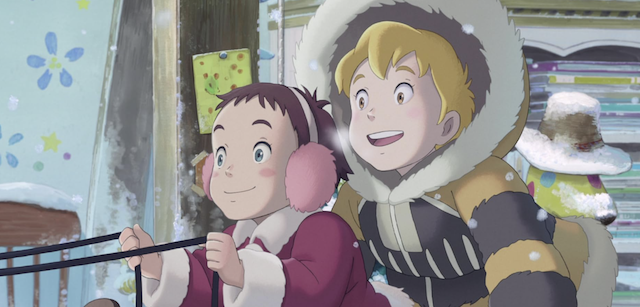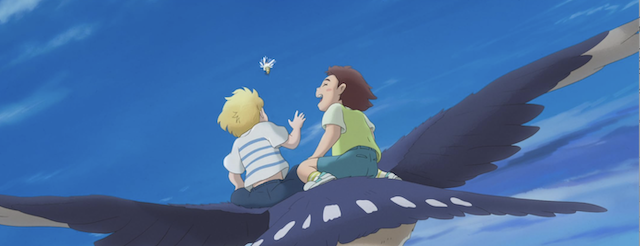
@Courtesy of Studio Ponoc/Netlfix
Japanese anime filmmakers have a bizarrely fantastic track record translating British young adult fantasies for the big screen. Studio Ghibli notably adapted Mary Norton’s The Borrowers (as The Secret World of Arrietty), Joan G. Robinson’s When Marnie Was There, and Diana Wynn Jones’ Howl’s Moving Castle (loosely, but it still counts), while Studio Ponoc based their first feature film release on Mary Stuart’s The Little Broomstick (as Mary and the Witch’s Flower).
They returned to English children’s lit for their second feature, continuing the successful trend. Thematically, director Yoshiyuki Momose’s tale of imaginary friends might sound similar to John Krasinski’s IF, but a richer, more complex fantasy world unfolds in The Imaginary, based on A.F. Harrold’s 2014 novel, which releases Friday in theaters and streams the following Friday on Netflix.
Rudger (not Rodger) looks like a boy Amanda’s age, but he happens to be her imaginary friend, who sprang up from her subconscious after her father’s untimely death. At least he was her invisible companion, until the young girl suffers an accident and slips into a coma. Without Amanda’s conscious memory of him, Rudger will dissipate into nothingness, like other imaginary friends forgotten by the grown children who once imagined them. Fortunately, Jinzan, a wise, big-eyed, cheshire-like cat, who enjoys great freedom of movement as an imaginary due to the peculiarities of his nature, finds Rudger before it is too late. @Courtesy of Studio Ponoc/Netlfix
@Courtesy of Studio Ponoc/Netlfix
Jinzan guides him to a sanctuary for forgotten imaginaries, secretly located in a human library, maintained by the collected imagination contained within its volumes. By day, the imaginaries congregate in the library, unobserved by the oblivious human clientele, but by night, their refuge transforms into one of the exotic locales extrapolated from the collection’s many exotic stories. Indeed, this fantastical world building greatly distinguishes The Imaginary from the recent bumper crop of imaginary friend movies (also including Blumhouse’s drastically different Imaginary—one article can make a world of difference).
He might be safe there, but Rudger cannot abandon Amanda, so he ventures out, hoping to find his way to her sickbed. Unfortunately, there is someone rather menacing out there, looking for him. Indeed, Momose’s The Imaginary also boasts an enormously creepy villain, whose powers, somewhat ironically, are derived from his childlike ability to imagine. In fact, to fuel his flights of fancy, the sinister Mr. Bunting consumes vulnerable imaginaries, very much like Rudger. Even creepier is the long-haired Sadako-like imaginary, who does Bunting’s bidding (perhaps reluctantly).
Both Momose and screenwriter-producer Yoshiki Nishimura (who founded Studio Ponoc) started their careers at Studio Ghibli, so it is not surprising The Imaginary has many lush and lovely scenes of fantastical wonder, in the Ghibli tradition. The character design is also quite distinctive, ranging from the eeriness of Bunting’s ghostly imaginary, to kid-friendly Fridge, a big furry dog, who was the former imaginary of Amanda’s mom, Lizzie.
@Courtesy of Studio Ponoc/Netlfix
Frankly, some scenes might be slightly more intense for younger viewers than the PG rating might suggest. Bunting is quite a malevolent fellow and the stakes Rudger and his fellow imaginaries face are considerable. Parents should probably be warned not every supporting character will survive unscathed. However, animation fans should definitely appreciate the artistry of the animation and the earnestness of its youthful characters.
The entire English voice cast nicely fit their characters, especially Kal Penn, who perfectly suits the mysterious Jinzan. Yet, the happiest surprise is how menacingly evil the typically nebbish Jeremy Swift (Leslie Higgins on Ted Lasso) sounds as Bunting. Plus, LeVar Burton adds warmth and nostalgic appeal (for Star Trek and Reading Rainbow fans) as loyal old Fridge.
The Imaginary creates a parallel imaginary ecosystem that is richly layered and consistently intriguing. It is tempting to say Momose’s film celebrates the power of imagination, but like any formidable tool, it can be used for good or for evil in the world Studio Ponoc has created. Regardless, the film looks great and it delivers just about everything admirers of quality anime could want. Very enthusiastically recommended for animation connoisseurs and bigger kids who enjoy the fantastical (with a few mild scares), The Imaginary releases this Friday (6/28) in theaters and starts streaming 7/5 on Netflix.
Grade: A
If you like the article, share your thoughts below!
Check out more of Joe’s articles.
Here’s the trailer of the film.

